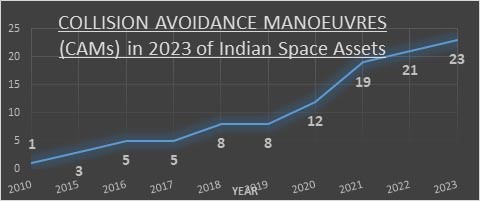PREVIOUS
ISSAR 2023 report
May 3 , 2024
207 days
553
0
- ISRO’s annual assessment of the prevailing space situation is also compiled in the form of the Indian Space Situational Assessment Report (ISSAR).
- Space assets operating in outer space are vulnerable to various environmental hazards - natural objects like asteroids, comets, and meteoroids, energy and particle flux, and artificial space objects.
- According to the report, about 1,37,565 close approach alerts were received from US Space Command.
- Also, a total of 3,033 alerts for close approaches within the distance of one kilometre were deduced by the ISRO satellites.
- Since the beginning of the Indian space era, a total of 127 Indian satellites, including those from private operators/academic institutions, have been launched till 31st December 2023.
- As of 31 Dec 2023, the number of operational satellites owned by Govt. of India is 22 in LEO (Low Earth Orbit) and 29 in GEO (Geo-synchronous Earth Orbit).
- In addition, three Indian deep space missions were also active by the end of 2023, namely, Chandrayaan-2 Orbiter, Aditya-L1, and the Propulsion Module of Chandrayaan-3.
- A total of 21 Indian satellites have re-entered the atmosphere till the end of 2023.
- In the year 2023 alone, 8 Indian satellites have re-entered the atmosphere.
- A total of 82 rocket bodies from Indian launches were placed in orbit till 2023.

Leave a Reply
Your Comment is awaiting moderation.


